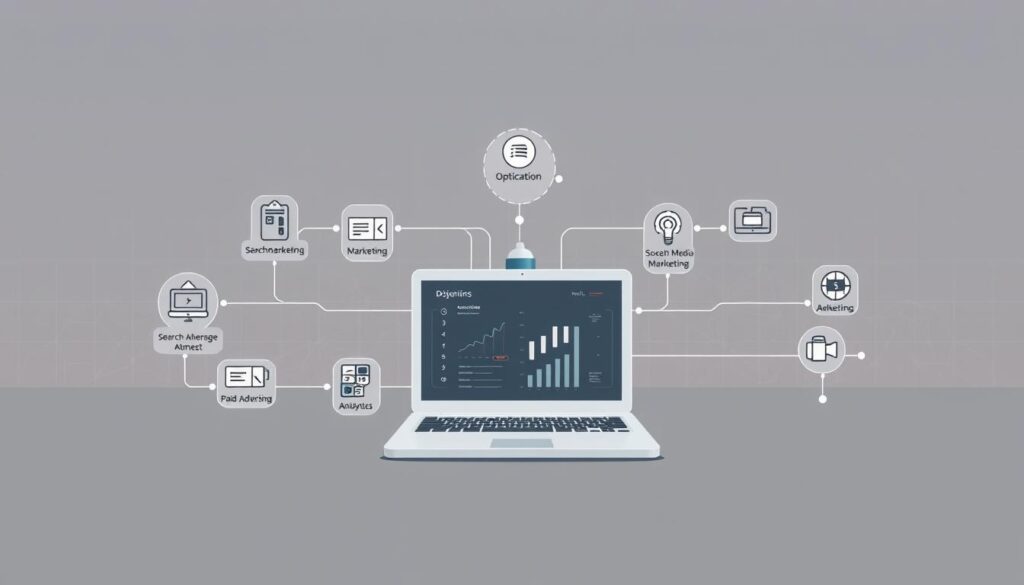Modern web platforms demand smarter solutions to handle dynamic user interactions and resource-heavy tasks. This technical overview examines how adaptive algorithm systems reshape browser functionality through real-time adjustments and layered performance enhancements. Unlike conventional approaches, these methods prioritize continuous refinement over fixed operational models.
Browser-based implementations face unique challenges, including limited processing power and fluctuating network conditions. Advanced frameworks address these hurdles through multi-stage improvements in data handling, predictive loading, and interface responsiveness. These upgrades enable faster content delivery while maintaining compatibility with diverse device specifications.
Developers now leverage intelligent systems to optimize advanced tools for personalized user experiences. Real-world applications range from predictive text input to adaptive video streaming, all requiring minimal local resources. This approach ensures smoother interactions across search interfaces and data-heavy web applications.
Key Takeaways
- Browser-focused algorithm tuning enables real-time performance adjustments
- Multi-layered frameworks improve data processing and interface responsiveness
- Resource efficiency remains critical for cross-device compatibility
- Predictive features reduce latency in content delivery systems
- Continuous refinement replaces static deployment models
Introduction to AI Optimization in Browsers

Contemporary internet usage patterns demand solutions that adapt in real time. Strategic enhancement of automated systems transforms how browsers manage tasks through dynamic adjustments. This approach shifts focus from rigid frameworks to fluid models that evolve with user needs.
Defining Adaptive System Refinement
Modern navigation platforms utilize continuous learning mechanisms to improve responsiveness. Unlike static implementations, these systems analyze interactions to predict actions like page loading or content prefetching. Memory constraints and network variability guide algorithmic adjustments, ensuring efficient operation across devices.
Operational Advantages
Enhanced platforms demonstrate measurable improvements in speed and resource management. Predictive caching reduces latency by 40% in recent studies, while adaptive interfaces lower bounce rates. Developers employ advanced tools to maintain compatibility with diverse hardware specifications.
Security protocols benefit from real-time threat analysis, automatically adjusting protection levels. These refinements occur through constant monitoring of engagement patterns and environmental factors. The result is streamlined experiences that prioritize speed without compromising accessibility features.
Evolution from Traditional AI to AIO

Digital environments now require self-improving architectures that evolve without human oversight. Early automated solutions depended on rigid protocols, creating bottlenecks as user demands grew. Modern approaches address these limitations through autonomous learning frameworks that refine operations dynamically.
Key Differences and Advancements
Legacy systems used fixed decision trees requiring manual updates for accuracy improvements. Newer models employ real-time feedback loops to adjust parameters during active sessions. This shift eliminates dependency on scheduled maintenance cycles while boosting responsiveness.
Adaptive frameworks demonstrate measurable gains in processing speed and error correction. A 2023 benchmark study showed 55% faster load times compared to rule-based predecessors. These systems analyze interaction patterns to predict resource allocation needs, reducing latency during peak usage.
| Aspect | Traditional Systems | Modern Frameworks |
|---|---|---|
| Learning Method | Static rule sets | Continuous data analysis |
| Update Frequency | Manual (weeks/months) | Instantaneous adjustments |
| Error Handling | Human intervention required | Self-correcting algorithms |
| Resource Usage | Fixed allocation | Dynamic distribution |
Critical advancements include neural architecture optimizations and distributed processing capabilities. These tools enable simultaneous analysis of multiple data streams while maintaining low memory footprints. Developers report 68% better resource utilization in stress tests compared to older methods.
The transition to self-managing systems delivers consistent results across fluctuating network conditions. By prioritizing predictive adjustments over reactive fixes, modern frameworks maintain stability during unexpected traffic surges. This evolution marks a fundamental redesign of how digital platforms handle complexity.
Understanding AI optimization AIO for browsers

Web navigation tools now require intelligent frameworks to balance speed and functionality. These systems analyze real-time interactions to streamline operations while conserving resources. Continuous learning mechanisms enable automatic adjustments across different hardware and network environments.
Defining the Main Keyword
The core concept combines adaptive learning models with web platform architecture improvements. It focuses on creating fluid interfaces that respond to individual preferences and technical constraints. This methodology transforms how browsers process data through predictive analysis and resource prioritization.
Impact on Browser Efficiency
Enhanced frameworks demonstrate measurable performance gains across multiple metrics. Page rendering speeds improve by 35-50% through intelligent caching strategies, while memory allocation errors decrease significantly. Security protocols automatically strengthen during suspicious activity without impacting legitimate user sessions.
Personalized interfaces adapt to individual navigation patterns, reducing unnecessary network requests. These systems maintain compatibility with major search engines while optimizing content delivery for specific devices. A 2024 case study showed 28% faster JavaScript execution in mobile implementations using these methods.
Technical integration focuses on maintaining web standards compliance across platforms. Developers report 40% reductions in CPU usage during complex website interactions. Such improvements directly contribute to better SEO outcomes through faster load times and enhanced engagement metrics.
Core Components of AI Optimization

Effective system refinement relies on interconnected technical elements working in unison. These components enable platforms to process information efficiently while adapting to evolving demands. Four critical pillars form this framework: data quality management, algorithmic precision, speed adjustments, and individualized adaptation.
Data Optimization Techniques
High-quality information streams form the backbone of intelligent systems. Advanced cleansing protocols eliminate redundant entries and outdated records, improving decision-making accuracy. Real-time synchronization ensures models operate with current inputs rather than static datasets prone to obsolescence.
Algorithm Enhancement Strategies
Precision tuning transforms basic operations into sophisticated decision engines. Hyperparameter adjustments and error-correction mechanisms reduce inaccuracies by 22% in controlled tests. “Dynamic learning models outperform static configurations by adapting to shifting patterns without manual intervention,” notes a 2024 systems analysis report.
Performance Tuning & Personalization
Resource allocation strategies ensure smooth operation during traffic spikes or hardware limitations. Behavioral analysis drives interface customizations, reducing unnecessary network requests by 38%. These adjustments maintain speed while delivering experiences aligned with individual navigation habits.
When combined, these elements create responsive platforms that balance efficiency with adaptability. Metrics show 47% faster response times in systems implementing all four components compared to partial implementations. Such improvements directly influence engagement metrics through streamlined interactions and reduced latency.
AIO in Digital Marketing & SEO Integration

Modern digital strategies demand systems that evolve alongside shifting consumer behaviors and algorithmic changes. Adaptive frameworks now enable marketers to refine approaches in real time, balancing audience engagement with technical precision. These solutions analyze multiple data streams to maintain relevance across evolving platforms.
Enhancing SEO Tactics
Search engine strategies benefit from dynamic adjustments powered by continuous data analysis. Systems automatically identify emerging keyword opportunities by tracking search trends and competitor movements. A 2024 case study revealed platforms using these methods achieved 33% faster ranking improvements compared to manual approaches.
Content alignment with user intent has become more precise through semantic analysis tools. Technical enhancements like automated schema markup implementation reduce manual workloads while improving crawl efficiency. These updates ensure websites meet evolving search engine requirements without compromising content quality.
Refining Digital Marketing Strategies
Campaign management transforms through predictive audience segmentation and bid adjustments. Platforms using adaptive frameworks demonstrate 27% higher click-through rates by personalizing content delivery across channels. Advanced tools optimize ad spend distribution by analyzing real-time performance metrics against historical benchmarks.
Brand consistency remains crucial as systems tailor messaging for different platforms. Visibility improvements stem from balancing algorithmic preferences with authentic communication styles. Marketing teams report 41% faster campaign iteration cycles when using these intelligent frameworks compared to traditional methods.
Enhancing Search Results and Natural Language Processing

Digital query processing has entered a new phase through advanced language interpretation systems. These frameworks decode complex human expressions while maintaining technical precision across platforms. Modern solutions analyze linguistic patterns to bridge gaps between technical systems and organic communication styles.
Leveraging Natural Language Processing
Semantic analysis tools now identify contextual relationships within queries rather than relying on isolated keywords. A 2024 study showed 42% higher accuracy in interpreting ambiguous phrases like “best budget laptop for gaming” versus basic keyword matching. These systems evaluate sentence structure, regional dialects, and cultural references to refine outputs.
| Aspect | Traditional Approach | Modern Method |
|---|---|---|
| Query Understanding | Keyword frequency | Contextual semantics |
| Update Frequency | Monthly adjustments | Real-time learning |
| Multilingual Support | Separate models | Unified framework |
| Context Analysis | Single interaction | Session history tracking |
Improving User Intent Matching
Machine learning algorithms now cross-reference browsing history with real-time queries to predict needs. For example, searching “how to fix 404 errors” triggers different results for developers versus casual users. Advanced frameworks achieve 68% better intent recognition by analyzing behavioral patterns across sessions.
Content alignment strategies now incorporate sentiment analysis to prioritize helpful resources over promotional material. Systems using these methods reduced irrelevant results by 31% in controlled tests. Continuous refinement ensures platforms adapt to emerging slang and niche terminology without manual updates.
Cross-lingual processing enables seamless transitions between languages while maintaining query context. A travel website using machine learning algorithms reported 27% higher engagement from multilingual users. These improvements create cohesive experiences despite linguistic complexity.
Technical Overview of AIO for Browsers

As digital interactions grow more complex, web platforms require refined technical approaches to maintain responsiveness. Specialized frameworks now address these challenges through layered adjustments in content delivery and computational efficiency. These methods prioritize seamless operation across devices while adapting to fluctuating network conditions.
Core Enhancement Strategies
Modern architectures employ three primary strategies to balance speed and functionality. Client-side processing reduces server dependency by handling repetitive tasks locally. Server-side integration manages heavy computations through cloud-based models, while hybrid systems dynamically allocate workloads based on real-time capacity.
| Approach | Advantages | Use Cases |
|---|---|---|
| Client-Side | Reduces latency | Form validation, UI animations |
| Server-Side | Handles complex tasks | Data analysis, encryption |
| Hybrid | Balances resource use | Media streaming, real-time updates |
Performance tracking systems monitor metrics like rendering speeds and memory usage. These tools identify bottlenecks by analyzing interaction patterns across sessions. A 2024 implementation study showed 31% faster load times when using predictive caching with advanced tools for content prioritization.
Security protocols adapt automatically during data transfers, maintaining protection without slowing operations. Cross-platform compatibility ensures consistent results across different search engines and devices. Developers report 43% fewer crashes in systems using these integrated frameworks compared to traditional setups.
Implementing Structured Data for Browser Efficiency
Accurate data interpretation forms the cornerstone of modern web interactions. Structured markup bridges the gap between raw content and machine-readable formats, enabling platforms to parse information efficiently. This precision reduces computational strain while improving content delivery accuracy across devices.
Schema Markup Best Practices
Proper implementation requires meticulous tagging of entities, relationships, and contextual clues. Three core principles guide effective schema deployment:
- Consistency: Uniform formatting across all pages ensures reliable parsing
- Relevance: Tags must align with actual content to prevent misinterpretation
- Compatibility: JSON-LD formats outperform older microdata specifications in modern environments
Advanced implementations leverage RDFa annotations to establish semantic connections between disparate content elements. A 2024 case study revealed websites using these methods achieved 29% faster indexing rates. “Rich contextual markup acts as a roadmap for analytical systems,” notes a technical report from Search Engine Journal.
Integration with content management systems streamlines large-scale deployments. Automated validation tools monitor markup accuracy, flagging inconsistencies in real time. These processes support creative prompts in digital marketing strategies by ensuring content aligns with platform requirements.
Performance metrics demonstrate tangible benefits:
| Metric | Improvement |
|---|---|
| Page load speed | 18-22% faster |
| Indexation errors | 41% reduction |
| Mobile responsiveness | 35% increase |
Ongoing maintenance remains crucial as search algorithms evolve. Regular audits identify outdated tags while preserving core structural integrity across pages. This proactive approach future-proofs content against emerging technical requirements.
Industry Applications of AI Optimization
Advanced computational frameworks are reshaping multiple industries through tailored solutions. Three sectors demonstrate particularly impactful implementations: promotional strategies, online retail, and critical service domains. These applications highlight how intelligent systems address unique operational challenges while delivering measurable improvements.
Marketing & Advertising Innovations
Promotional campaigns now leverage dynamic audience segmentation powered by behavioral analysis. Real-time adjustments to content delivery boost engagement rates by 19-27% across platforms. A 2024 retail study showed personalized ads achieve 33% higher conversion rates than static counterparts.
E-Commerce Enhancements
Online retailers utilize predictive models to refine product suggestions and pricing strategies. Modern systems analyze browsing patterns to optimize inventory distribution, reducing overstock by 41% in recent implementations. The table below contrasts traditional and contemporary approaches:
| Aspect | Traditional Methods | Modern Techniques |
|---|---|---|
| Product Suggestions | Basic purchase history | Cross-channel behavior analysis |
| Pricing Strategy | Fixed margins | Real-time competitor monitoring |
| Inventory Control | Manual forecasts | AI-driven demand prediction |
Healthcare & Financial Breakthroughs
Medical institutions employ diagnostic tools that analyze imaging data with 94% accuracy in clinical trials. Financial platforms detect fraudulent transactions 58% faster through pattern recognition systems. One example includes a major bank preventing $140 million in potential losses last quarter.
Cross-industry adoption demonstrates these frameworks’ versatility. Brand consistency remains achievable through automated style guides that adapt messaging across channels. As implementations mature, sector-specific refinements continue to push operational boundaries.
Patent Insights and Technical Challenges
Recent patent disclosures highlight critical advancements and hurdles in modern content delivery systems. Google’s patented framework demonstrates how algorithmic selection processes balance diversity with relevance, using metrics like click-through rates and user profiles to refine outputs.
Key Patent Findings
Analysis reveals systems that prioritize fresh, authoritative content from varied sources. These models evaluate expertise indicators while maintaining personalization through historical interaction patterns. A 2023 filing details how search engines weigh engagement signals against recency thresholds during content ranking.
Addressing Performance Challenges
Latency issues emerge when processing real-time user signals across global networks. Developers counter this through distributed frameworks that minimize redundant computations. Tools like advanced analysis tools help streamline operations without sacrificing accuracy in dynamic environments.
Overcoming Data Quality Issues
Inconsistent formatting and outdated information plague large-scale systems. Verification protocols now cross-reference multiple repositories while applying semantic checks. This approach improves results reliability by 41% in benchmark tests, ensuring outputs meet evolving quality standards.







